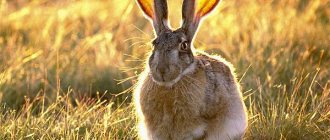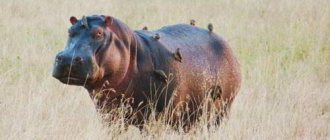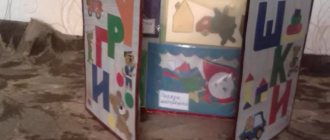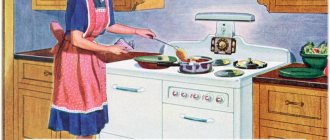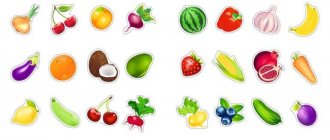Interactive presentation manual “Mushrooms”
Presentation "MUSHROOMS"
(for children of senior preschool age (5-7 years old))
Target:
formation in preschoolers of specific ideas about edible and inedible mushrooms, to distinguish them by appearance. Promote the development of cognitive interest.
The presentation can be used in classes, leisure activities (quiz games, KVNs, etc.), for conducting conversations.
Instructions.
The slides switch sequentially in accordance with the text of the conversation. At the beginning of the presentation there is a slide with picture buttons, with which you can optionally go to a description of a particular mushroom or to games.
On the slides describing mushrooms there are also buttons to return to the slide with picture buttons and a button to go to games.
The presentation offers interactive games (with triggers). The correctness of the answers is checked by “clicking” on the picture.
Slide No. 1 – title slide.
Slide number 2
Using the picture buttons on this slide (by clicking the mouse), you can go to a description of any of the mushrooms or to games.
Slide number 3
Educator.
This porcini mushroom, also called boletus, is the most desired find of a mushroom picker - beautiful, tasty, amazingly aromatic.
Slide number 4
Educator.
Guys, why do you think this mushroom is called white?
Children's answers.
Educator.
It got its name because of its pulp: it is white, does not change color when cut, and remains white both in dried and boiled mushrooms.
Slide No. 5
Educator.
The lower part of the cap of a young mushroom is white, but then becomes yellow-green. But the upper side of the boletus cap varies - from dark brown to light, almost white.
Slide No. 6
Educator.
The leg is short and thick, white or slightly brownish. The mushroom grows in spruce, pine and birch forests.
Slide No. 7
Educator.
The porcini mushroom is very beautiful and tasty, which is why all mushroom pickers have loved it for a long time.
Slide No. 8
Educator.
Among the porcini mushrooms there are real giants!
Using the hyperlinks at the bottom of the screen, you can return to the slide with picture buttons or go to the games.
Slide No. 9
Educator.
And this is a boletus. The top of its cap is orange, brown or red. That's why it is also called redhead. The bottom of the cap is gray.
Slide No. 10
Educator.
The leg of the boletus is thick and widens towards the bottom. Covered with scales, they come in white, gray, and black colors. The flesh of the mushroom quickly darkens when cut.
Slide No. 11
Educator.
It grows in deciduous and mixed forests, often in places where there are many young aspens. This is where it got its name. Found in large groups.
Slide No. 12
Educator.
Boletus is a very tasty mushroom. For any mushroom picker it is a welcome find.
Slide No. 13
Educator.
It is eaten boiled, fried, dried and pickled.
Using the hyperlinks at the bottom of the screen, you can return to the slide with picture buttons or go to the games.
Slide No. 14
Educator.
This is a boletus. It looks a little like both a porcini mushroom and a boletus. But its cap is softer, its leg is thinner and longer. When cut, the mushroom darkens a little.
Slide No. 15
Educator.
The color of the cap varies: from light gray to dark brown. This is a very common edible mushroom.
Slide No. 16
Educator.
The boletus can be found on the edges and hills, in places where there is enough solar heat and light. It grows singly and in groups. Many boletus can be found in young birch trees, hence its name. It is fried, pickled, and dried.
Using the hyperlinks at the bottom of the screen, you can return to the slide with picture buttons or go to the games.
Slide No. 17
Educator.
This is a flywheel. Moss mushroom is a mushroom with a velvety, dry or slightly sticky cap of golden brown, reddish or greenish color. The underside of the cap is yellow or yellow-greenish. The leg is smooth, sometimes slightly wrinkled.
Slide No. 18
Educator.
When cut, the mushroom quickly turns blue, but this does not spoil its taste. The moss mushroom is fried, salted, pickled, and dried. Why is the mushroom called that? Because it can often be found on the ground covered with moss.
Using the hyperlinks at the bottom of the screen, you can return to the slide with picture buttons or go to the games.
Slide No. 19
Educator.
Russulas are mushrooms that vary greatly in the color of their caps. They are pink, yellow, red, brown, greenish. There are white or yellowish plates on the underside of the cap. The stem is smooth and white.
Slide No. 20
Educator.
Russulas are very tender and brittle, and sometimes, by the time you bring them home, only crumbs remain, so not all mushroom pickers like to collect them. But despite this, russulas are very tasty.
Using the hyperlinks at the bottom of the screen, you can return to the slide with picture buttons or go to the games.
Slide No. 21
Educator.
This is a trumpet mushroom - an edible mushroom, widespread and very productive. The cap of the volnushka is pink or pinkish-red, with a curled, shaggy edge, and in the middle it is depressed and wet. The underside of the cap, like that of russula, is covered with plates.
Slide number 22
Educator.
If you break off a piece of mushroom, milk-white juice will appear on the break. Volnushki are salted, but before that they must be soaked in water to remove the bitterness. They can be eaten only a month after salting.
Using the hyperlinks at the bottom of the screen, you can return to the slide with picture buttons or go to the games.
Slide No. 23
Educator.
This mushroom is called bitter. Its cap is brownish-red. Both young and old mushrooms have a pointed tubercle in the center of the cap, and the underside is covered with plates.
Slide No. 24
Educator.
The pulp of the bitter is dense and brittle. When damaged, it produces bitter white juice. Bitters are salted and pickled. To remove bitterness, they, like volushki, are soaked in water.
Using the hyperlinks at the bottom of the screen, you can return to the slide with picture buttons or go to the games.
Slide No. 25
Educator.
This is a fly agaric. It is visible from afar. Its bright color with white spots attracts the attention of mushroom pickers. But everyone knows that it is poisonous to humans. But moose, deer, cows, goats and magpies eat this mushroom with pleasure.
Slide No. 26
Educator.
Even despite such a formidable name - “fly pest”, it does not seem to kill flies, but only intoxicates them. After some time, they come back to life again. The red fly agaric is one of the brightest and most beautiful mushrooms of the autumn forest.
Using the hyperlinks at the bottom of the screen, you can return to the slide with picture buttons or go to the games.
Slide No. 27
Educator.
This is a pale toadstool, it is considered the most dangerous poisonous mushroom. It can look different, most often it has a greenish cap and a white leg. Sometimes the pallid grebe is completely white.
Slide No. 28
Educator.
But it always has white plates under the cap, a white ring on the stem and a white torn sac at the bottom of the mushroom. The poison of the pale toadstool is not destroyed even when cooked. It affects internal organs unnoticed by a person within two days. And now I invite you to play!
Using the hyperlinks at the bottom of the screen, you can return to the slide with picture buttons or go to the games.
Slide No. 29
Educator.
Name the mushrooms you see on the screen?
The correctness of the answer is checked using a gramophone in the lower right corner of each picture (the name of the mushroom is heard).
Slide No. 30
Educator.
What are these mushrooms called?
The correctness of the answer is checked using a gramophone in the lower right corner of each picture (the name of the mushroom is heard).
Slide No. 31
Educator.
Name the mushrooms you see. Which one is the odd one out, and why?
The correct answer is checked using the mouse. When you click on an extra picture, it “fades”.
Slide No. 32
Educator.
Name these mushrooms. Which one is extra?
The correct answer is checked using the mouse. When you click on an extra picture, it “fades”.
Slide No. 33
Educator.
Name edible mushrooms.
The correct answer is checked using the mouse. When you click on edible mushrooms, they move to the basket.
7
Riddles about mushrooms
For example, you can offer the following poems and riddles:
My hat -
Where the needles are.
Glistens in the sun
It slips in your hands. (oiler)
With a thick leg, small,
He hid in the moss... (boletus).
If I get into the basket -
You will have a supply for the winter.
I taste very good!
Did you guess it? This is... (milk).
They lead a friendly round dance
Red sisters.
Everyone will immediately understand:
In front of him... (chanterelles).
Sits bravely on a stump
A bunch of brave guys.
Everyone can easily recognize them:
Who doesn’t know about….(again)?
All shades and colors
Those mushrooms have caps.
Collect them without haste,
Very fragile...(russula).
Look at the video riddles about mushrooms:
As a conclusion to the lesson, to include motor memory in the work, in the final part we invite the kids to work with coloring. The mushroom coloring page puts kids in a calm mood.
Summary of GCD for children in the middle group of kindergarten with a presentation on the topic: Mushrooms
Summary of educational activities in the middle group on the topic: “Oh, mushrooms, mushrooms”
Author: Lyubov Nikolaevna Komova, teacher at MBDOU “Kindergarten No. 90”, Cherepovets. Description of the material: I bring to your attention a summary of direct educational activities on the topic: “Oh, mushrooms, mushrooms.” This material will be useful to teachers of children in the 5th year of life at preschool educational institutions.
Goal: Getting to know mushrooms. Objectives: Educational:
Expand children's knowledge about mushrooms (name, place of growth, structure); teach to distinguish between edible and inedible mushrooms.
Developmental:
Develop children's active vocabulary (names of mushrooms)
Educational:
Foster respect for nature and friendliness.
Materials and equipment: • Basket with mushrooms, covered with a handkerchief • Audio recording “Sounds of the forest” • Caps of edible mushrooms according to the number of children • Squirrel (bi-ba-bo) • Models of mushrooms (ceps, boletus, boletus, chanterelles, fly agaric, pale toadstool) Educational areas: • Cognitive development • Social and communicative development Preliminary work: 1. Reading V. Kataev “Mushrooms”, V. Suteev “Under the Mushroom” 2. Examination of the album with illustrations “Mushrooms” Progress: The teacher brings a basket to the group, covered with a handkerchief. Attracts children's attention.
Educator: Children, look what I have in my hands! Want to know what's there? Children: Yes! Educator: In the summer it grows in the forest, but does not go into the basket on its own. You need to bow to him, cut off the leg, don’t be lazy, then he will take off his hat, food from him is delicious. What grows under the hat, doesn’t go into the basket itself? Children: Mushroom. The teacher removes the handkerchief and shows the children mushrooms. Educator: Children, where do you think these mushrooms come from? Children: (children's assumptions) Educator: Where do mushrooms grow? Children: In the forest. Educator: I propose to go into the forest and find out who sent us such a gift. The children agree. The teacher turns on the audio recording “Sounds of the Forest.” Teacher: We are going to the forest today. Children walk in circles.
That forest is full of miracles!
It rained in the forest yesterday - They shake their brushes.
This is very good.
They clap their hands.
We will look for mushrooms.
They put their palm to their forehead
and collect them in a basket.
They squat down and pick mushrooms.
Here the boletus are sitting.
They point to the right with their hand
. There is a honey mushroom on the stump.
They point to the left with their hand
. Well, and you, fly agaric,
shake your finger.
Decorate the autumn forest.
Good forest, old forest. Children walk in a circle
Full of fabulous wonders!
We are going for a walk now and inviting you with us! Educator: Here we are in the forest. Look how many mushrooms there are around. Let's take a closer look. Children sit on a rug (in a clearing). Slide No. 1 White mushroom
Educator: Near a hillock on the path, a mushroom stands on a thick stalk. A little damp from the rain, the porcini mushroom is large and important. Educator: This mushroom is called a porcini mushroom. It has a stem and a cap. ( Shows)
What color is the mushroom cap?
Children: The hat is brown. Educator: What color is the mushroom stem? Children: The leg is white. Educator: The porcini mushroom has a very thick and strong leg. If you cut this mushroom, it will be white in the middle. Hence the name of this mushroom. The white mushroom is considered the king of mushrooms (the main one in the forest). Because it is the largest mushroom in the forest and valuable (delicious). Mushroom pickers love it very much. Who are mushroom pickers? Children: People who pick mushrooms. Slide No. 2 Boletus
Educator: How good are the tough guys in red hats! I'll collect them early in the morning under the aspen tree. This mushroom is called boletus. It grows under aspen, which is why it is called boletus. Educator: What does the boletus have? Children: Leg and hat. Educator : What color is the hat? Children: The hat is red. Educator: And the leg? Children: The leg is white with black ones. Slide No. 3 Boletus
Educator: We have one more mushroom in front of us. Educator: This is a boletus. Why do you think it is called that? Children: Grows under a birch tree. Educator: Under the birch tree in front there is a boletus, look, on a tall slender leg... The leg is a little speckled! How is it different from boletus? Children: With a hat. The boletus has a brown cap. Slide No. 4 Chanterelles
Educator: Here are the beautiful foxes. Very friendly sisters. It is not easy for them to hide. It can be seen very far away. Educator: Who can tell why these mushrooms are called that? Children: They are red, like foxes. Educator: Children, what mushrooms did we find in the clearing? Children: Chanterelles, boletus, boletus, porcini mushroom. Educator: All these mushrooms can be eaten, you can cook different dishes from them (fry, dry, cook mushroom soup). Therefore, all of them can be called edible. An outdoor game “Mushroom Picker and Mushrooms” is played. According to the counting, a mushroom picker is selected, the rest of the children are mushrooms (they put a cap with a picture of a mushroom on their head) Educator: Here is a forest clearing, There are edible mushrooms here. I invite everyone to the game, We play, you drive! Mushrooms grow in a clearing, at the teacher’s signal “The mushroom picker is coming,” the children run away and the mushroom picker catches. The game is played several times. After the game, the children sit down. A squirrel appears. Squirrel: Hello, children! Children: Hello, squirrel! Squirrel: What are you doing in the forest? Children: We want to know who sent us a basket of mushrooms as a gift. Squirrel : It's me. In summer there are a lot of mushrooms in the forest. But you need to be careful, in addition to edible mushrooms, inedible ones also grow in the forest. Educator: Squirrel, let's introduce the children to inedible mushrooms. Slide No. 5 Fly agaric
Educator: This mushroom grows in the forest. Don’t put it in your mouth! It's not sweet at all. Specks on the cap. Red like a tomato. Inedible fly agaric! Look what a fly agaric looks like. Children: White leg, red cap with white dots. Educator: It is beautiful and bright, but very dangerous because it is poisonous. Under no circumstances should you touch it with your hands or even kick it. Slide No. 5 Pale grebe
Educator: Here is another mushroom that is poisonous to humans. Pale-faced grebes wander in a flock through the clearing. I won't play with them. I'll go around and forget about it. Why should you avoid these mushrooms? Children: They are poisonous, inedible, and should not be touched. Educator : Never eat unfamiliar berries... And you don’t need to put mushrooms in your mouth: your head will spin, your stomach will hurt, and the doctor won’t save you from poisoning. Educator: What mushrooms did we meet? Children: Edible and inedible. Didactic game “Collect mushrooms” Models of familiar mushrooms are laid out in the clearing; children collect only edible ones. Squirrel: Look how many mushrooms are in the clearing! Children, help me collect edible mushrooms. Educator: Finding mushrooms is not difficult. You need to take them carefully. You need to know them well, so as not to collect toadstools. After the children have collected mushrooms, the teacher asks each one what mushroom he found. Educator: What can you call all the mushrooms that we collected? Children: Edible mushrooms. Educator: What mushrooms are left in the clearing? Children: Inedible, poisonous. Educator: Let's name them. Children: Fly agaric, pale grebe. Educator: We've played enough with mushrooms, and now it's time for us to go to mom. The children thank the squirrel and return to the group.
Presentation on the topic: Mushrooms
We recommend watching:
Autumn holiday in the middle group. Scenario “Fruit Joy” Poem for children 5-9 years old about mushrooms Presentation “Mushrooms” for kindergarten. Preparatory group Presentation for preschoolers on the topic “Mushrooms”
Similar articles:
Poems about mushrooms for children 5-7 years old in kindergarten
Riddles about mushrooms for children 6-7 years old with short answers
Autumn games for middle school children in kindergarten
Morning exercises in the middle group. November
Card index of walks in the middle group according to the Federal State Educational Standard with goals. September
